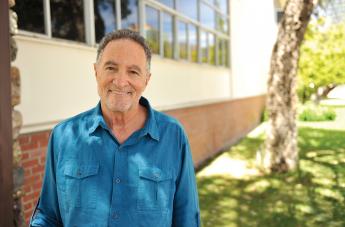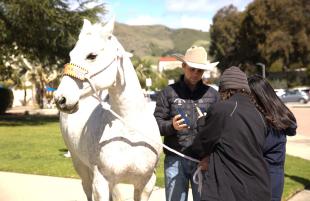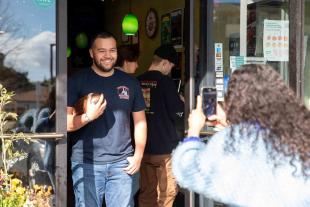COVID-19 Offers a Real-World Laboratory for Students in Disruptive Technology Course

During spring quarter of 2020, associate professor of entrepreneurship and co-founder of the Cal Poly Center for Innovation and Entrepreneurship Jonathan York taught BUS 408: Entrepreneurship through Disruptive Technologies.
Bringing together entrepreneurship students from across campus, the course focuses on the theory of disruptive innovation and its use in creating business and entrepreneurial opportunity — lessons that became particularly timely and real against the disruption of a pandemic.
According to York, most students are knowledgeable about their personal technology, which they interact with every day, and the technology in the fields they study.
“In the meantime, there are all different kinds of technologies outside of us that will change the way we live in many ways,” he said. “These are things that students aren’t normally exposed to.”
Each time York teaches the class, he picks eight different technologies for the students to study during the quarter. In order to help develop a better understanding of these technologies, York brings in outside experts to speak to the class. The students then have to study each technology and write papers about them. Afterward, they are put into groups where they each have to select one additional technology that wasn’t covered to teach to their classmates.
Examples of these include artificial emotional intelligence, brain computer interface, advanced energy, and quantum computing.
“These are things you hear about that seem far down the line—so we’re thinking ahead,” York said.
Another focus of the course is asking what type of implications these technologies may have on businesses and how this may change in the future. York also asks his students how these technologies could change society. Some implications are ethical and some are cultural.
“Every student has been asked to consider what’s going to happen in two decades when they’re 40 and they’re in charge,” York said.
Due to the COVID-19 pandemic, York was forced to teach this year course online, which meant that right at the beginning of the quarter, the class began having discussions about what a real disruption is — and engaging with each other through a virtual, technology-delivered platform.
“One of the main subjects we talked about is how this disruptive event is going to accelerate the way in which disruptive technologies affect our lives in the future,” York said. “The question is how will things be different afterward? It’s been like a real-world laboratory.”
When he taught the course last quarter, York said, things seemed a lot more hypothetical.
“The curriculum was delivered in kind of a vacuum,” he said. “We were sitting in a classroom and accepted that the world worked how it worked and that things would eventually change at some point. But right now, we are in the middle of a change, and the discussions we had this spring reflected that.”
In one session, the class discussed whether or not this specific disruption would decelerate the field of genetic engineering as medical experts pivoted to address the outbreak. The group concluded that the field is actually likely to leap ahead significantly due to the virus.
“What we’re learning right now is that we’ve got to figure out how to cure people of diseases at the core level, meaning how to work with technologies that were more theoretical a year ago,” York said.
One guest lecturer, mechanical engineering professor Thomas Mackin, described the parallels between how technology advances and how viruses spread. While the goal in epidemiology is to stop viral upticks, the goal in business is often to avoid flattening the curve of an emerging technology’s popularity.
“Look at which factors increase virality, and which factors are holding it back,” York said. “If I’m trying to get my software or my invention to go viral, I’m looking at increasing it. If I’m trying to stop a disease, I’m looking at decreasing it. It’s the same numerical model.”
Last year, York divided his students into small groups to walk around campus and come back to tell the class how they felt higher education would be different in 15 years because of the technologies that they were studying. This year, with the class online, he had them walk around their houses or neighborhoods and the think about the world at large instead. Once again, they had to come back to the Zoom class and break down certain technologies by discussing what they saw and extrapolate how it may affect life in the future.
One COVID-related development which came up was telemedicine — ranging from diagnosing patients online via a Zoom conversation to surgery via robots and remote machinery.
“It’s not until now that there has actually been a tipping point where something like that is needed,” York said. “We discussed how we’re going to see a big change in the speedy adoption of telemedicine, which would have never had happened if it weren’t for COVID-19. The situation is an accelerant.”
When York first started developing the course, he did extensive research to find out if anyone else was teaching a similar class but didn’t find any curricula that matched his. The material has been something that he and his students have had to pioneer through their conversations.
“It’s really just taking a group of college students from multiple majors and spending 10 weeks together looking at disruptive technologies that are going to play a role in the most important decisions they’re going to make in their lives as leaders, as citizens, as family members, as innovators, as anything,” York said.



